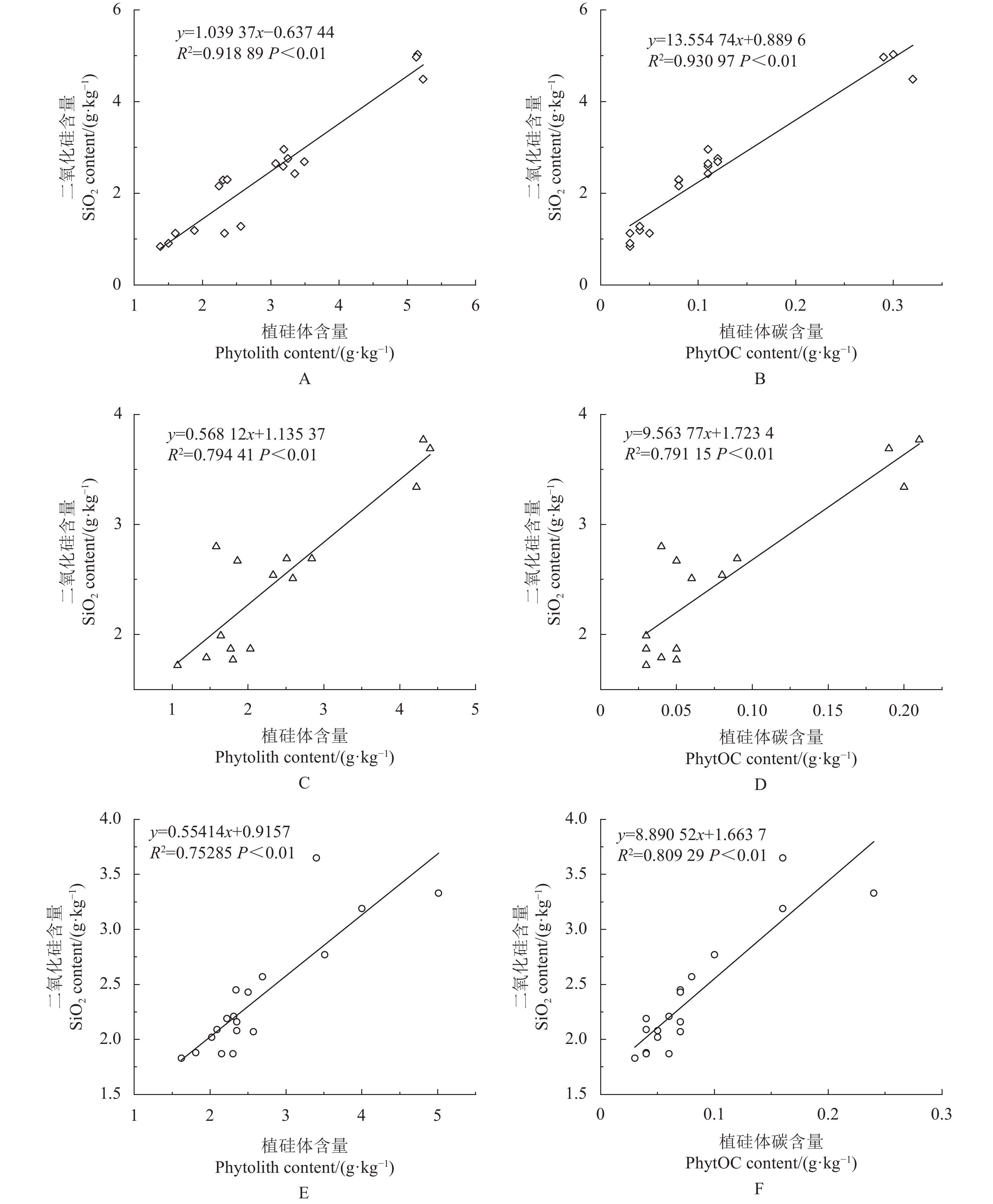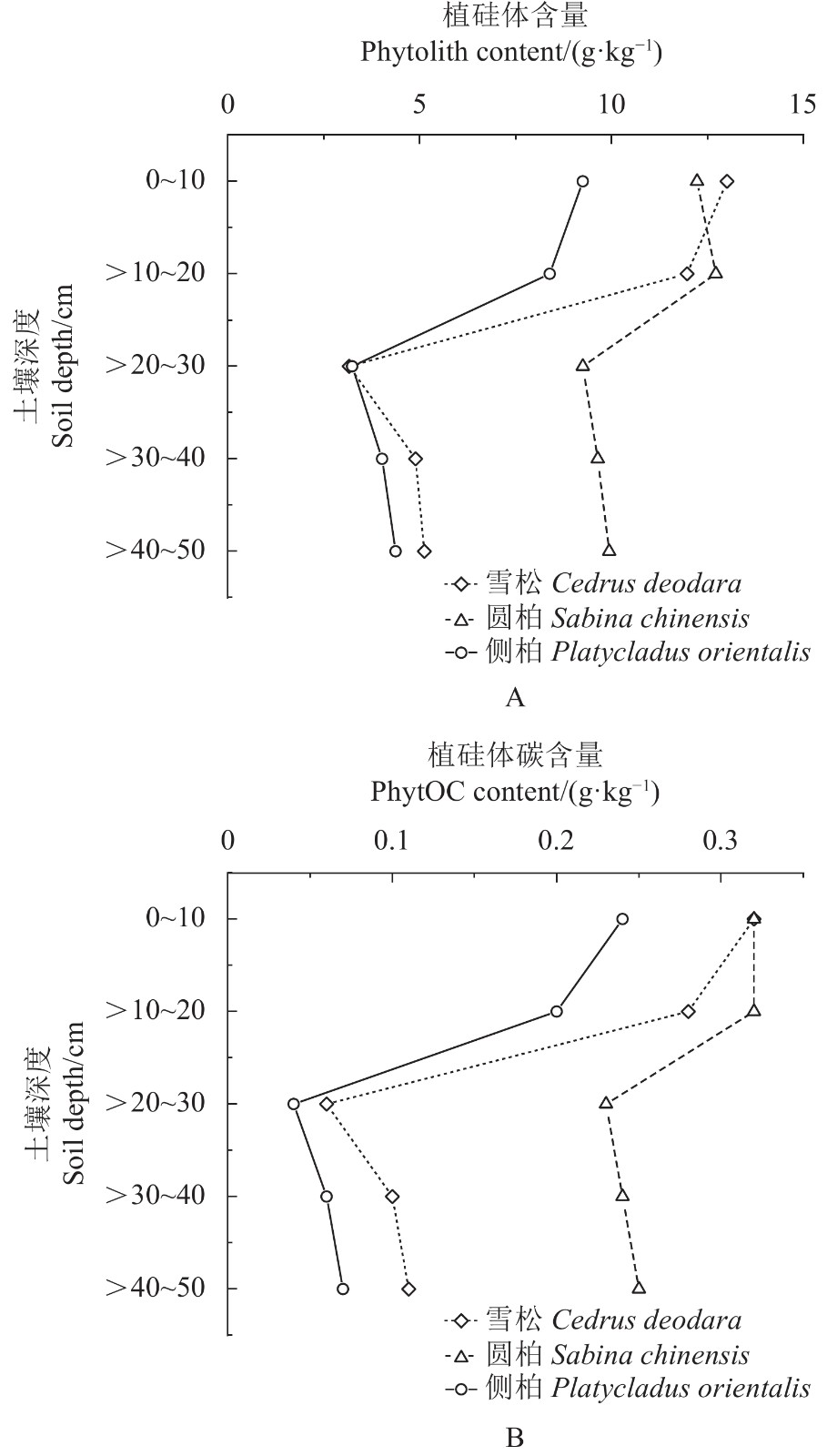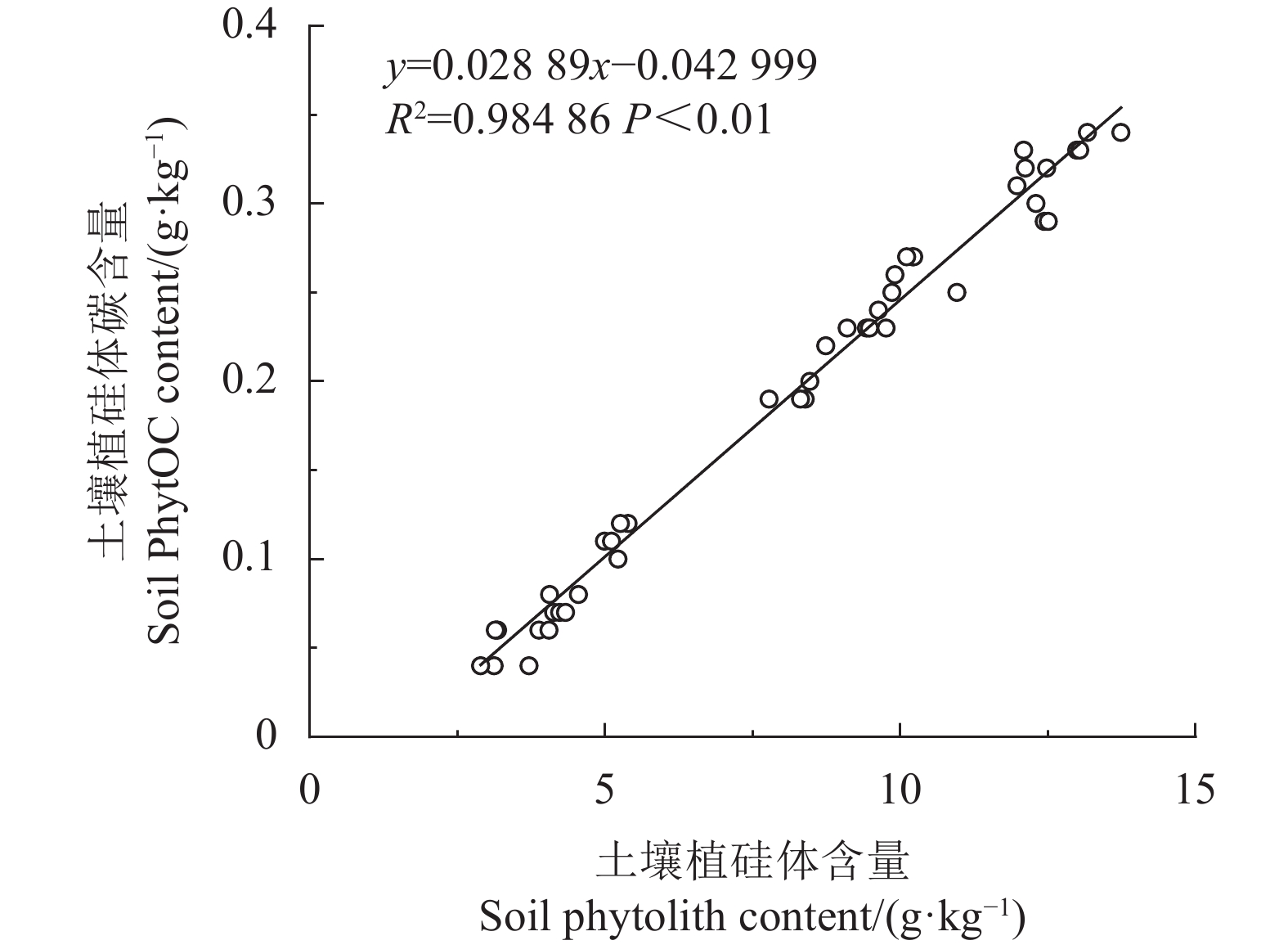Storage and Stability of Phytolith-occluded Carbon in Three Typical Coniferous Forests at Mt. Funiu
-
摘要:
目的 通过对伏牛山3种针叶林植物器官、枯落物和土壤中植硅体及植硅体碳的研究,探讨不同林分间植硅体碳的封存特性及稳定性差异,为长期固碳提供理论依据。 方法 在伏牛山的雪松(Cedrus deodara)、圆柏(Sabina chinensis)、侧柏(Platycladus orientalis)3种森林中对植物各器官、枯落物和0~50 cm深的土壤剖面进行采样,基于质量平衡法研究了土壤与植物体内的植硅体、植硅体碳和二氧化硅(SiO2)的含量。 结果 雪松各器官植硅体含量在1.49~3.27 g·kg−1,植硅体碳含量在0.030~0.114 g·kg−1。圆柏各器官植硅体含量在1.44~2.56 g·kg−1,植硅体碳含量在0.036~0.085g·kg−1。侧柏各器官植硅体含量在1.86~2.90 g·kg−1,植硅体碳含量在0.038~0.083 g·kg−1。本研究估算了植硅体碳在各林分中的生产通量与周转时间,圆柏林中土壤植硅体碳储量(1.64 t·hm−2)高于雪松林(1.17 t·hm−2)和侧柏林(0.77 t·hm−2),且圆柏林植硅体碳周转时间(1813.16 a)长于雪松林(218.78 a)和侧柏林(556.44 a)。 结论 不同的森林类型对植硅体及植硅体碳的生产速率和周转时间会有显著影响,在未来的针叶林森林管理计划中优化圆柏的造林/再造林会显著增强未来几个世纪的生物地球化学碳汇。 Abstract:Objective Sequestration and stability of phytoliths and phytolith-occluded carbon (PhytOC) in plant organs, ground litter, and soil in three typical coniferous forests at Mt. Funiu in Henan province were analyzed to better understand the long-term carbon fixation in the eco-system. Method Contents of phytoliths, C in phytoliths, PhytOC, and SiO2 in the plant organs, ground litter, and 0-50 cm soil in Cedrus deodara, Sabina chinensis, and Platycladus orientalis forests at Mt. Funiu were collected according to the mass balance method. Result The contents of phytoliths, C in phytoliths, PhytOC, and SiO2 in various organs of the trees and soil of the forests in the area varied significantly. The phytolith contents in the plant organs ranged 1.49-3.27 g·kg−1 for C. deodara, 1.44-2.56 g·kg−1 for S. chinensis , and 1.86-2.90 g·kg−1 for P. orientalis, while the PhytOC at the C. deodara forest, 0.030-0.114 g·kg−1, at the S. chinensis forest, 0.036-0.085 g·kg−1, and at the P. orientalis forest, 0.038-0.083 g·kg−1. The production fluxes estimated by this study indicated that the soil PhytOC storage at the S. chinensis forest was 1.64 t·hm−2, which was higher than 1.17 t·hm−2 at the C. deodara forest and 0.77 t·hm−2 at the P. orientalis forest. The estimated PhytOC turnover time for the S. chinensis forest soil was 1 813.16 a, which was significantly longer than 218.78 a for the C. deodara forest soil or 556.44 a for the P. orientalis forest soil. Conclusion Significant variations existed on the phytolith content in the plant organs and the PhtyOC production rate and turnover time of the soil at the 3 forests. By optimizing and/or re-establishing the coniferous S. chinensis forest in the mountain, the biogeochemical carbon sink of the environment could be significantly enriched. -
Key words:
- Phytolith /
- PhtyOC /
- soil profile /
- coniferous forest /
- production flux /
- turnover time
-
图 1 不同植物体内植硅体与植硅体碳、二氧化硅的相关性
A、B分别为雪松植物体内植硅体与植硅体碳、二氧化硅相关性;C、D分别为圆柏植物体内植硅体与植硅体碳、二氧化硅相关性;E、F分别为侧柏植物体内植硅体与植硅体碳、二氧化硅相关性。
Figure 1. Correlations between phytoliths and PhytOC or SiO2 in plant organs at various forests
A or B: Correlation between phytoliths and PhytOC or SiO2 in plant organs at C. deodara forest; C or D: correlation between phytoliths and PhytOC or SiO2 in plant organs at S. chinensis forest; E or F: correlation between phytoliths and PhytOC or SiO2 in plant organs at P. orientalis forest.
表 1 供试不同森林中不同树种器官中的植硅体、植硅体中有机碳、植硅体碳和SiO2含量
Table 1. Phytoliths and C in phytoliths, PhytOC, and SiO2 in plant organs at forests
器官
Organs植硅体含量
Phytoliths content/(g·kg−1)植硅体中有机碳含量
C in phytoliths/(g·kg−1)植硅体碳含量
PhytOC content/(g·kg−1)SiO2含量
SiO2 content/(g·kg−1)雪松雄花序
Cedar male inflorescence3.24±0.08 c 33.94±0.81 c 0.110±0.002 c 2.66±0.22 c 雪松松针
Cedar leaf3.27±0.17 c 34.82±1.36 c 0.114±0.005 c 2.70±0.05 c 雪松枝
Cedar branch2.22±0.28 ef 19.34±1.43 f 0.043±0.004 fgh 1.20±0.06 g 雪松干
Cedar trunk1.49±0.09 gh 20.23±1.81 f 0.030±0.001 h 0.96±0.12 g 雪松根
Cedar root2.30±0.05 ef 36.01±0.52 c 0.083±0.001 de 2.25±0.06 d 圆柏叶
Sabina chinensis leaf1.78±0.16 fgh 20.53±1.61 f 0.036±0.006 gh 1.91±0.06 ef 圆柏枝
Sabina chinensis branch1.44±0.30 h 29.16±1.48 d 0.042±0.007 gh 1.76±0.03 f 圆柏干
Sabina chinensis trunk2.01±0.43 efg 25.29±2.40 f 0.051±0.006 fgh 2.66±0.12 c 圆柏根
Sabina chinensis root2.56±0.21 de 33.33±0.47 c 0.085±0.006 d 2.64±0.07 c 侧柏果
Platycladus orientalis fruit2.22±0.11 ef 19.34±1.51 f 0.043±0.004 fgh 2.12±0.05 de 侧柏叶
Platycladus orientalis leaf1.86±0.22 fgh 20.53±1.20 f 0.038±0.006 gh 1.86±0.02 ef 侧柏枝
Platycladus orientalis branch2.30±0.22 ef 25.29±1.75 f 0.058±0.009 efg 2.10±0.08 de 侧柏干
Platycladus orientalis trunk2.33±0.02 ef 29.16±1.31 d 0.068±0.004 def 2.16±0.24 de 侧柏根
Platycladus orientalis root2.9±0.44 cd 28.57±0.33 de 0.083±0.013 de 2.59±0.14 c 雪松枯落物
Cedar litter5.17±0.04 a 58.62±1.96 a 0.303±0.012 a 4.83±0.24 a 圆柏枯落物
Sabina chinensis litter4.31±0.07 b 46.72±1.86 b 0.201±0.005 b 3.60±0.19 b 侧柏枯落物
Platycladus orientalis litter4.13±0.66 b 45.23±3.42 b 0.187±0.040 b 3.39±0.19 b 同列不同小写字母表示不同森林类型与不同器官间差异显著(P<0.05)。
Data with different lowercase letters on same column indicate significant difference at P<0.05.表 2 研究区森林0~50 cm土壤深度内土壤容重(BD)、酸碱度(pH)、植硅体碳含量、植硅体中有机碳含量、植硅体碳含量和SiO2含量
Table 2. Bulk density, pH, phytoliths, C in phytoliths, PhytOC, and SiO2 in 0-50 cm soil at various forests
森林类型
Forest type土壤深度
Soil depth/cm土壤容重
BD酸碱度
pH植硅体含量
Phytoliths content/
(g·kg−1)植硅体中有机碳含量
C in phytoliths/
(g·kg−1)植硅体碳含量
PhytOC content/
(g·kg−1)SiO2含量
SiO2 content/
(g·kg−1)雪松林
Cedar forest0~10 1.27 9.25 13.01±0.59 a 24.89±0.60 b 0.32±0.018 a 12.09±0.16 a >10~20 1.32 7.21 11.97±0.71 b 23.01±0.21 c 0.28±0.018 b 12.22±0.47 a >20~30 1.33 7.01 3.16±0.02 i 19.36±0.76 e 0.06±0.003 ge 2.83±0.16 g >30~40 1.41 7.12 4.89±0.59 fg 20.63±0.98 d 0.10±0.015 ef 4.77±0.10 f >40~50 1.47 7.25 5.12±0.11 f 22.16±0.33 c 0.11±0.004 e 5.49±0.05 e 圆柏林
Sabina chinensis forest0~10 1.14 7.04 12.23±0.18 ab 26.48±0.51 a 0.32±0.004 a 10.00±0.38 b >10~20 1.18 6.95 12.72±0.53 ab 25.51±0.18 ab 0.32±0.014 a 9.77±0.26 b >20~30 1.22 7.06 9.25±1.06 cd 24.82±1.04 b 0.23±0.029 c 6.95±0.41 d >30~40 1.23 7.10 9.64±0.18 c 24.94±0.20 b 0.24±0.006 c 6.98±0.15 d >40~50 1.23 7.02 9.94±0.33 c 25.63±0.90 ab 0.25±0.017 bc 7.14±0.16 d 侧柏林
Platycladus orientalis forest0~10 1.22 7.17 9.25±0.49 cd 25.57±0.17 ab 0.24±0.014 c 7.91±0.72 c >10~20 1.29 7.24 8.39±0.07 e 23.31±0.33 c 0.20±0.004 d 6.98±0.37 d >20~30 1.31 7.16 3.24±0.35 i 12.40±0.82 g 0.04±0.002 e 2.47±0.34 g >30~40 1.31 7.03 4.02±0.10 gh 15.57±0.44 f 0.06±0.003 ge 2.64±0.10 g >40~50 1.33 7.01 4.37±0.13 fg 16.30±0.49 f 0.07±0.004 fg 2.70±0.37 g 不同小写字母表示不同林分与不同土层间差异显著(P<0.05)。
Data with different lowercase letters on same column indicate significant difference at P<0.05.表 3 3种森林类型中植硅体生产通量、植硅体碳生产通量、植硅体碳储量和周转时间
Table 3. Phytolith production flux, PhytOC production flux, PhytOC storage and turnover time at 3 types of forest
森林类型
Forest type植硅体生产通量
Phytolith production flux/
(kg∙hm−2∙a−1)植硅体碳生产通量
PhytOC production flux/
(kg∙hm−2∙a−1)植硅体碳储量
PhytOC storage/
(t∙hm−2)周转时间
Turnover time/a雪松林
Cedar forest9.13 0.53 1.17 218.78 圆柏林
Sabina chinensis forest1.94 0.09 1.64 1813.16 侧柏林
Platycladus orientalis forest3.05 0.14 0.77 556.44 -
[1] IPCC. Land Use, Land Use Change and Forestry. Special Report, Inter-Governmental Panel on Climate Change[M]. Cambridge: Cambridge University Press, 2000. [2] 孟赐福, 姜培坤, 徐秋芳, 等. 植物生态系统中的植硅体闭蓄有机碳及其在全球土壤碳汇中的重要作用 [J]. 浙江农林大学学报, 2013, 30(6):921−929. doi: 10.11833/j.issn.2095-0756.2013.06.018MENG C F, JIANG P K, XU Q F, et al. PhytOC in plant ecological system and its important roles in the global soil carbon sink [J]. Journal of Zhejiang A & F University, 2013, 30(6): 921−929.(in Chinese) doi: 10.11833/j.issn.2095-0756.2013.06.018 [3] LAW B E, HARMON M E. Forest sector carbon management, measurement and verification, and discussion of policy related to climate change [J]. Carbon Management, 2011, 2(1): 73−84. doi: 10.4155/cmt.10.40 [4] KORNER C. Carbon limitation in trees [J]. Journal of Ecology, 2003, 91(1): 4−17. doi: 10.1046/j.1365-2745.2003.00742.x [5] DEWAR R C, CANNELL M G R. Carbon sequestration in the trees, products and soils of forest plantations: An analysis using UK examples [J]. Tree Physiology, 1992, 11(1): 49−71. doi: 10.1093/treephys/11.1.49 [6] SONG Z L, WANG H L, STRONG P J, et al. Plant impact on the coupled terrestrial biogeochemical cycles of silicon and carbon: Implications for biogeochemical carbon sequestration [J]. Earth-Science Reviews, 2012, 115(4): 319−331. doi: 10.1016/j.earscirev.2012.09.006 [7] JANSSON C, WULLSCHLEGER S D, KALLURI U C, et al. Phytosequestration: Carbon biosequestration by plants and the prospects of genetic engineering [J]. BioScience, 2010, 60(9): 685−696. doi: 10.1525/bio.2010.60.9.6 [8] SONG Z L, PARR J F, GUO F S. Potential of global cropland phytolith carbon sink from optimization of cropping system and fertilization [J]. PLoS One, 2013, 8(9): e73747. doi: 10.1371/journal.pone.0073747 [9] JONES L H P, MILNE A A. Studies of silica in the oat plant [J]. Plant and Soil, 1963, 18(2): 207−220. doi: 10.1007/BF01347875 [10] PARR J F, SULLIVAN L A. Soil carbon sequestration in phytoliths [J]. Soil Biology and Biochemistry, 2005, 37(1): 117−124. doi: 10.1016/j.soilbio.2004.06.013 [11] 加鹏华, 李春雨, 尹海魁, 等. 太行山区不同海拔梯度土壤有机碳库及组分变化特征 [J]. 林业与生态科学, 2021, 36(3):269−276.JIA P H, LI C Y, YIN H K, et al. Changes of soil organic carbon pools and their components in different altitudinal gradients in Taihang Mountains [J]. Forestry and Ecological Sciences, 2021, 36(3): 269−276.(in Chinese) [12] ZUO X X, LU H Y, GU Z Y. Distribution of soil phytolith-occluded carbon in the Chinese Loess Plateau and its implications for silica-carbon cycles [J]. Plant and Soil, 2014, 374(1): 223−232. [13] ZUO X X, LÜ H Y. Carbon sequestration within millet phytoliths from dry-farming of crops in China [J]. Chinese Science Bulletin, 2011, 56(32): 3451−3456. doi: 10.1007/s11434-011-4674-x [14] PARR J F, SULLIVAN L A. Phytolith occluded carbon and silica variability in wheat cultivars [J]. Plant and Soil, 2011, 342(1): 165−171. [15] LI Z M, SONG Z L, JIANG P K. Biogeochemical sequestration of carbon within phytoliths of wetland plants: A case study of Xixi wetland, China [J]. Chinese Science Bulletin, 2013, 58(20): 2480−2487. doi: 10.1007/s11434-013-5785-3 [16] 尹帅, 姜培坤, 孟赐福, 等. 绿竹和麻竹地上部植硅体碳封存潜力 [J]. 生态学报, 2017, 37(20):6827−6835.YIN S, JIANG P K, MENG C F, et al. Comparison of PhytOC sequestration rates in above-ground apart of Dendrocalamopsis oldhami(Munro) Keng f. and Dendrocalamus latiflorus Munro [J]. Acta Ecologica Sinica, 2017, 37(20): 6827−6835.(in Chinese) [17] 王霞, 胡海波, 程璨, 等. 北亚热带麻栎林土壤植硅体碳储量研究 [J]. 浙江农林大学学报, 2021, 38(1):1−9. doi: 10.11833/j.issn.2095-0756.20200283WANG X, HU H B, CHENG C, et al. Soil PhytOC sequestration in Quercus acutissima forest in northern subtropics [J]. Journal of Zhejiang A & F University, 2021, 38(1): 1−9.(in Chinese) doi: 10.11833/j.issn.2095-0756.20200283 [18] LI B L, SONG Z L, WANG H L, et al. Phytolith carbon sequestration in bamboos of different ecotypes: A case study in China [J]. Chinese Science Bulletin, 2014, 59(34): 4816−4822. doi: 10.1007/s11434-014-0474-4 [19] SONG Z L, LIU H Y, LI B L, et al. The production of phytolith-occluded carbon in China’s forests: Implications to biogeochemical carbon sequestration [J]. Global Change Biology, 2013, 19(9): 2907−2915. doi: 10.1111/gcb.12275 [20] FAO U. World reference base for soil resources 2014. International soil classification system for Naming soils and creating legends for soil maps[M]. ROME: World Soil Resources Reports No 106, 2014. [21] 鲁如坤. 土壤农业化学分析方法[M]. 北京: 中国农业科技出版社, 2000. [22] PARR J F, SULLIVAN L A. Comparison of two methods for the isolation of phytolith occluded carbon from plant material [J]. Plant and Soil, 2014, 374(1): 45−53. [23] LI Z M, SONG Z L, PARR J F, et al. Occluded C in rice phytoliths: Implications to biogeochemical carbon sequestration [J]. Plant and Soil, 2013, 370(1): 615−623. [24] WALKLEY A, BLACK I A. An examination of the degtjareff method for determining soil organic matter, and a proposed modification of the chromic acid titration method [J]. Soil Science, 1934, 37(1): 29−38. doi: 10.1097/00010694-193401000-00003 [25] SONG Z L, LIU H Y, SI Y, et al. The production of phytoliths inC hina’s grasslands: Implications to the biogeochemical sequestration of atmosphericCO2 [J]. Global Change Biology, 2012, 18(12): 3647−3653. doi: 10.1111/gcb.12017 [26] 冯宗炜, 王效科, 吴刚. 中国森林生态系统的生物量和生产力[M]. 北京: 科学出版社, 1999. [27] WEBB E A, LONGSTAFFE F J. Climatic influences on the oxygen isotopic composition of biogenic silica in prairie grass [J]. Geochimica et Cosmochimica Acta, 2002, 66(11): 1891−1904. doi: 10.1016/S0016-7037(02)00822-0 [28] CORNELIS J T, RANGER J, ISERENTANT A, et al. Tree species impact the terrestrial cycle of silicon through various uptakes [J]. Biogeochemistry, 2010, 97(2): 231−245. [29] 林维雷, 应雨骐, 姜培坤, 等. 浙江南部亚热带森林土壤植硅体碳的研究 [J]. 土壤学报, 2015, 52(6):1365−1373.LIN W L, YING Y Q, JIANG P K, et al. Study on phytolith-occluded organic carbon in soil of subtropical forest of southern Zhejiang [J]. Acta Pedologica Sinica, 2015, 52(6): 1365−1373.(in Chinese) [30] VAN ELSAS J D, TREVORS J T, VAN OVERBEEK L S. Influence of soil properties on the vertical movement of genetically-marked Pseudomonas fluorescens through large soil microcosms [J]. Biology and Fertility of Soils, 1991, 10(4): 249−255. doi: 10.1007/BF00337375 [31] BURKHARDT M, KASTEEL R, VANDERBORGHT J, et al. Field study on colloid transport using fluorescent microspheres [J]. European Journal of Soil Science, 2007, 59(1): 82−93. doi: 10.1111/j.1365-2389.2007.00989.x [32] FISHKIS O, INGWERSEN J, LAMERS M, et al. Phytolith transport in soil: A field study using fluorescent labelling [J]. Geoderma, 2010, 157(1/2): 27−36. [33] CLARKE J. The occurrence and significance of biogenic opal in the regolith [J]. Earth-Science Reviews, 2003, 60(3/4): 175−194. [34] ALEXANDRE A, MEUNIER J D, COLIN F, et al. Plant impact on the biogeochemical cycle of silicon and related weathering processes [J]. Geochimica et Cosmochimica Acta, 1997, 61(3): 677−682. doi: 10.1016/S0016-7037(97)00001-X [35] FRAYSSE F, POKROVSKY O S, SCHOTT J, et al. Surface properties, solubility and dissolution kinetics of bamboo phytoliths [J]. Geochimica et Cosmochimica Acta, 2006, 70(8): 1939−1951. doi: 10.1016/j.gca.2005.12.025 [36] LI Z M, SONG Z L, CORNELIS J T. Impact of rice cultivar and organ on elemental composition of phytoliths and the release of bio-available silicon [J]. Frontiers in Plant Science, 2014, 5: 529. [37] SOMMER M, JOCHHEIM H, HÖHN A, et al. Si cycling in a forest biogeosystem–the importance of transient state biogenic Si pools [J]. Biogeosciences, 2013, 10(7): 4991−5007. doi: 10.5194/bg-10-4991-2013 [38] FRAYSSE F, POKROVSKY O S, SCHOTT J, et al. Surface chemistry and reactivity of plant phytoliths in aqueous solutions [J]. Chemical Geology, 2009, 258(3/4): 197−206. [39] YANG X M, SONG Z L, LIU H Y, et al. Phytolith accumulation in broadleaf and conifer forests of Northern China: Implications for phytolith carbon sequestration [J]. Geoderma, 2018, 312: 36−44. doi: 10.1016/j.geoderma.2017.10.005 -








 下载:
下载:



